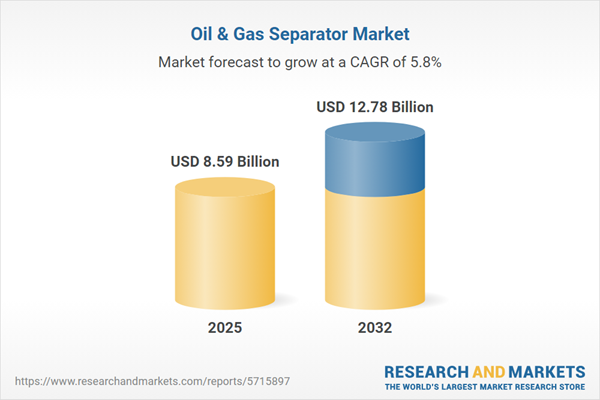Speak directly to the analyst to clarify any post sales queries you may have.
Effective separation technologies remain fundamental to optimizing operational performance in hydrocarbon processing. The oil & gas separator market continues to evolve as digitalization, new materials, and regulatory requirements reshape modern energy strategies for producers and infrastructure providers.
Market Snapshot: Oil & Gas Separator Market
The oil & gas separator market grew from USD 8.14 billion in 2024 to USD 8.59 billion in 2025. It is projected to continue expanding at a CAGR of 5.79%, achieving a value of USD 12.78 billion by 2032. This growth is driven by rising operational requirements, expanding exploration, upstream production, midstream investments, and intensified compliance with global energy and emission standards. Leaders in this space are rapidly adopting innovative separation systems across varied environments to increase efficiency and reduce operational risks.
Scope & Segmentation
This report delivers a comprehensive review of the oil & gas separator industry, covering a diverse set of technologies and applications:
- Separator Types: Cyclonic separator, production separator, scrubber, test separator
- Phase Types: Three-phase, two-phase systems
- Orientation Types: Horizontal, spherical, vertical
- Separation Mechanisms: Centrifugal, filtration, gravity, thermal aided
- Materials: Alloy steel (chromium based, nickel based), carbon steel, stainless steel
- Pressure Classes: High pressure (500-1500 Psi), low pressure (< 500 Psi)
- Phase Handling: Gas-liquid, gas-solid, liquid-liquid, oil-gas-water
- Capacities: Large, medium, small
- Applications: Downstream (petrochemical, refining), midstream (storage, transportation), upstream (exploration, production)
- Customer Types: EPC contractor, independent E&P, oilfield services company, refining & petrochemical firms
- Installation Environments: Offshore, onshore
Regional coverage encompasses:
- Americas: United States, Canada, Mexico, Brazil, Argentina, Chile, Colombia, Peru
- Europe, Middle East & Africa: United Kingdom, Germany, France, Russia, Italy, Spain, Netherlands, Sweden, Poland, Switzerland, United Arab Emirates, Saudi Arabia, Qatar, Turkey, Israel, South Africa, Nigeria, Egypt, Kenya
- Asia-Pacific: China, India, Japan, Australia, South Korea, Indonesia, Thailand, Malaysia, Singapore, Taiwan
Leading companies are profiled, including Alfa Laval AB, Baker Hughes Company, Halliburton Energy Services, Inc., Schlumberger Limited, TechnipFMC plc, Honeywell International Inc., and more.
Key Takeaways for Senior Decision-Makers
- Modern separation systems play an essential role in maintaining process safety, equipment longevity, and throughput across the hydrocarbon value chain.
- Rising environmental standards and emission controls are driving increased adoption of digital monitoring, predictive maintenance, and low-emission separator designs.
- Advanced materials, such as high-performance alloys and corrosion-resistant coatings, are vital for performance in sour gas and high-pressure environments.
- Segmented capacity solutions allow firms to phase infrastructure investments from exploration pilots to large-scale processing, supporting operational flexibility and risk management.
- Strategic supplier partnerships and regional adaptation are necessary due to rapid shifts in global trade, regulatory complexity, and distinct local infrastructure needs.
Tariff Impact: Adapting to New U.S. Policy
Recent U.S. tariff schedules have altered oil & gas separator supply chains by increasing costs for imported alloy steel and specialized internals. Companies are responding by reassessing sourcing, validating alternate material grades, and improving domestic manufacturing capacity. This shift is strengthening local fabrication and prompting cross-functional collaboration to safeguard supply continuity and compliance with performance standards.
Methodology & Data Sources
This analysis is built on a multi-phased research approach, combining in-depth interviews with industry experts, secondary research from technical publications and databases, and rigorous data triangulation. Independent expert validation ensures reliability, incorporating feedback to refine findings and recommendations.
Why This Report Matters
- Gain a holistic understanding of market segmentation—by separator type, phase handling, region, and application—to support informed investment and operational planning.
- Benchmark supplier strategies and innovation cycles to anticipate the impact of digitalization and regulatory shifts on separator selection.
Conclusion
Oil & gas separator market trends reflect a convergence of technology, sustainability, and policy. Strategic alignment across engineering, procurement, and compliance functions is key to leveraging new opportunities and managing evolving operational demands.
Additional Product Information:
- Purchase of this report includes 1 year online access with quarterly updates.
- This report can be updated on request. Please contact our Customer Experience team using the Ask a Question widget on our website.
Table of Contents
3. Executive Summary
4. Market Overview
7. Cumulative Impact of Artificial Intelligence 2025
Companies Mentioned
The companies profiled in this Oil & Gas Separator market report include:- Alfa Laval AB
- Baker Hughes Company
- ACS Manufacturing, Inc.
- Anpam Engineering
- Beijing Fractal Technology Co. Ltd.
- CECO Environmental Corp.
- eProcess Technologies Pty Ltd.
- ERGIL
- Fabtech Projects and Engineers Ltd.
- GEA Group
- Halliburton Energy Services, Inc.
- HAT International Ltd.
- JGC HOLDINGS CORPORATION
- Jiangsu Hongxun Oil Equipment Co., Ltd.
- Mar-Quinn Industries Ltd.
- Multitex Group
- NOV Inc.
- Pentair plc
- Schlumberger Limited
- Shaanxi Jixin Industrial Co., LTD.
- Shandong Sparta Machinery Co., Ltd.
- Sulzer Ltd.
- TechnipFMC plc
- The Godrej and Boyce Mfg. Co. Ltd.
- Veolia Water Technologies and Solutions
- Honeywell International Inc.
Table Information
| Report Attribute | Details |
|---|---|
| No. of Pages | 197 |
| Published | November 2025 |
| Forecast Period | 2025 - 2032 |
| Estimated Market Value ( USD | $ 8.59 Billion |
| Forecasted Market Value ( USD | $ 12.78 Billion |
| Compound Annual Growth Rate | 5.7% |
| Regions Covered | Global |
| No. of Companies Mentioned | 27 |









